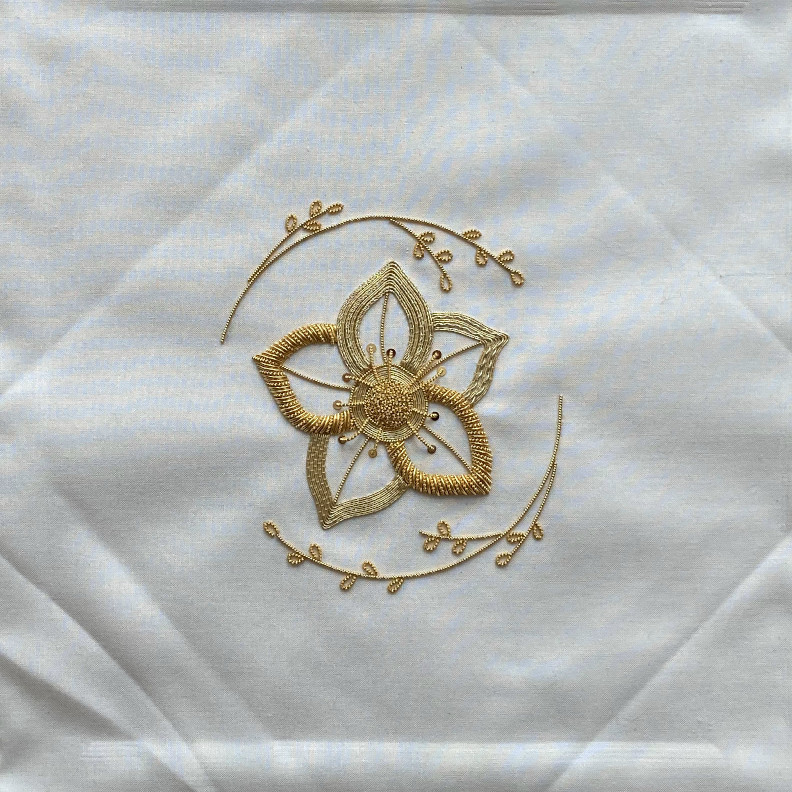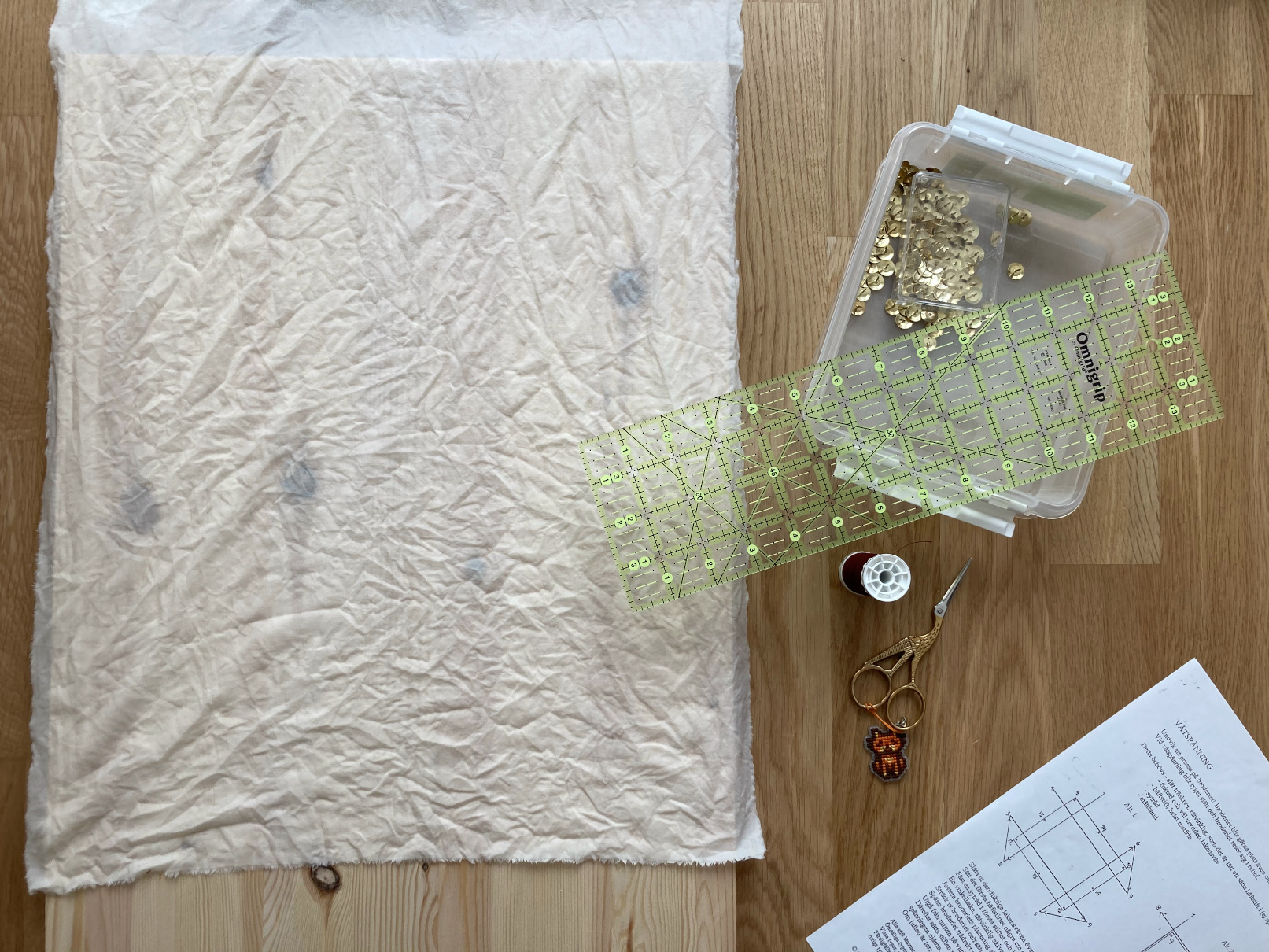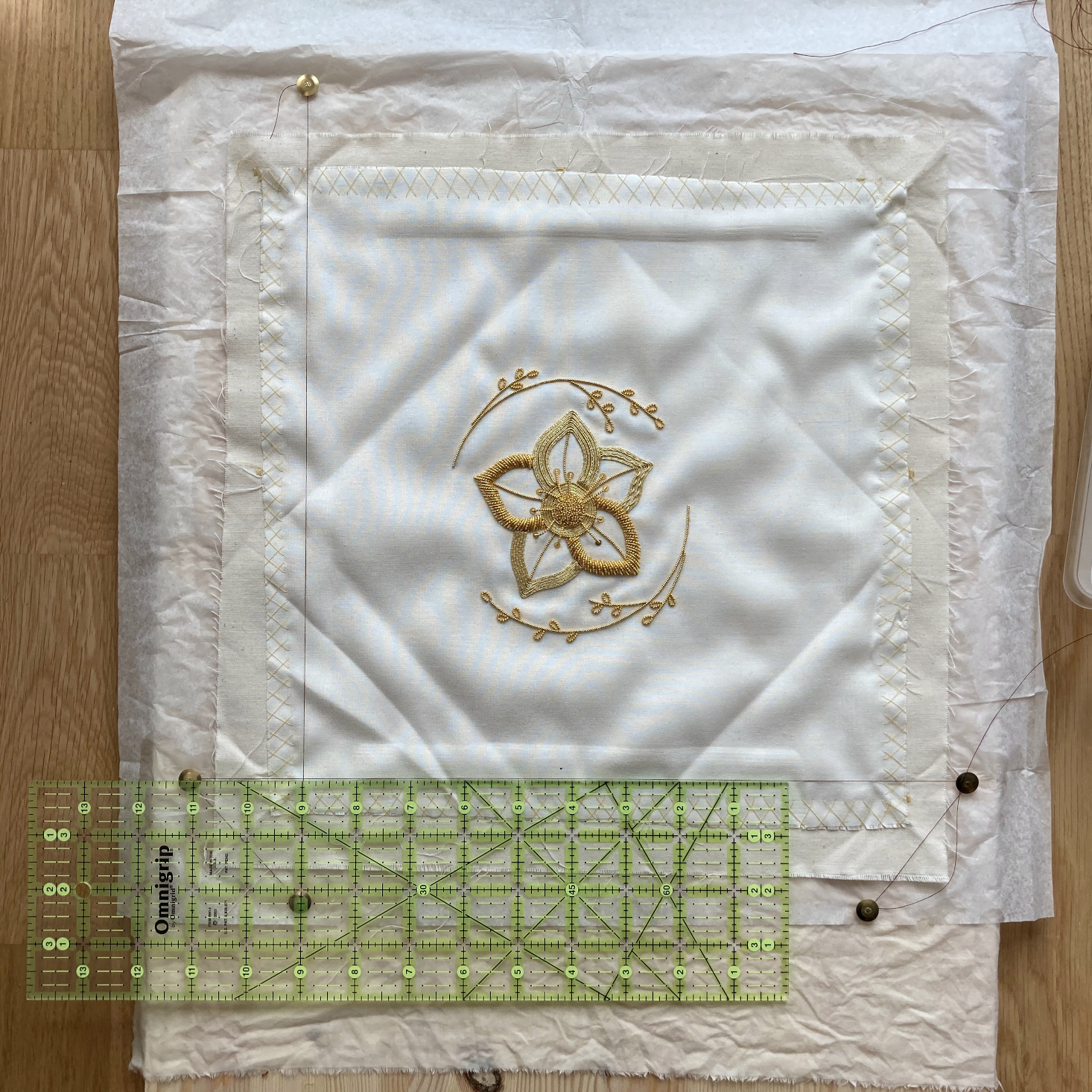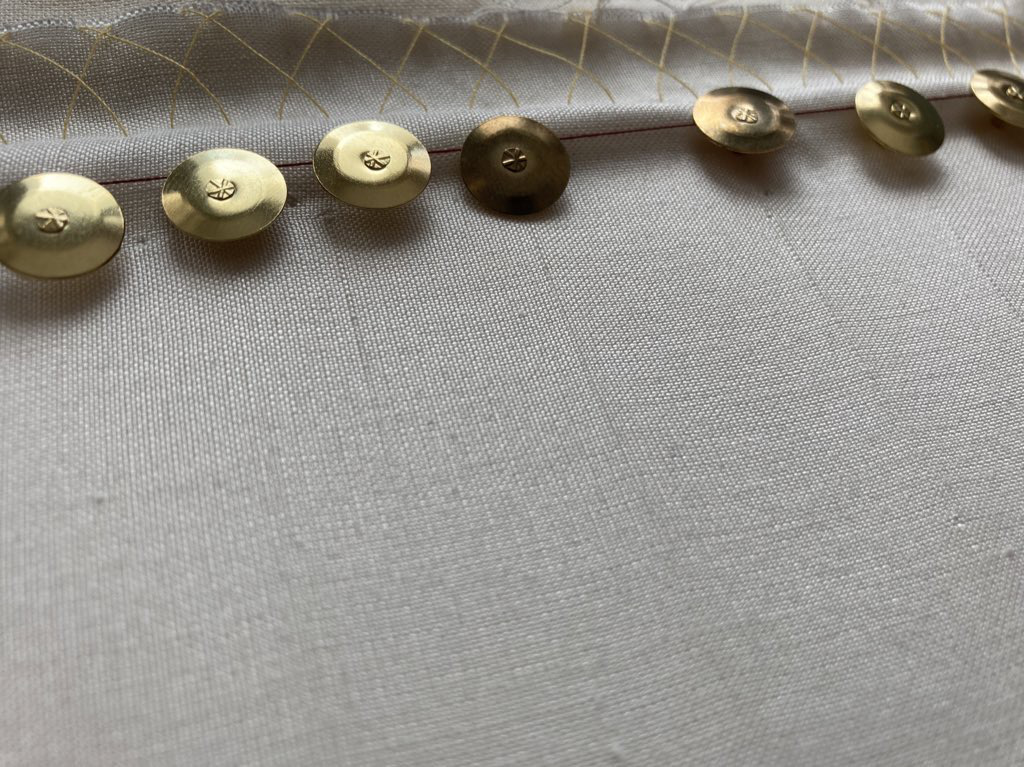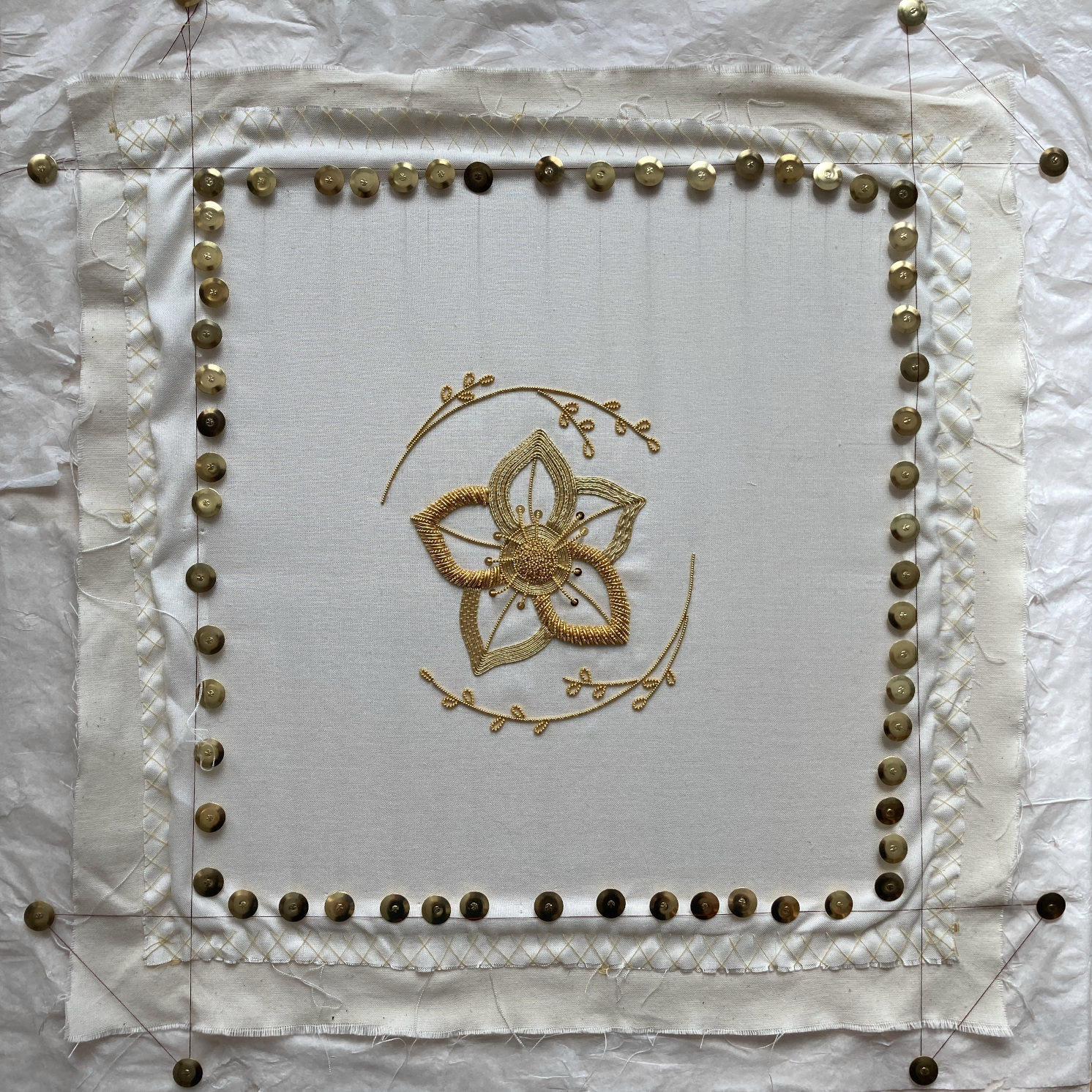Finishing embroidery the hard way: wet-stretching
Embroidery is always time-consuming. By the time a piece is done, it will have taken a significant number of hours, and you will want to finish it in a way that makes all that hard work shine. Taking it to the framer is pretty common, though you will need to make sure they know how to work with embroidery. There are also about a million tutorials for putting the finished work in a hoop. But you might want to do things differently, or do them yourself. And because I'm formally trained, I've got a whole bunch of tricks that I don't see in any tutorials. Here they are for all to use!
The piece used as an example is my execution of the Royal School of Needlework's goldwork kit. It is sold with their excellent online class. Unfortunately, the silk fabric decided to mess with my camera and many of the process pictures have bizarre blue-yellow stripes as a result: I will hopefully update this article with better pictures from a different project next time I assemble one.
This is part 1 of a series, and primarily discusses planning and wet-stretching. Part 2 will cover stretching the piece on a stretcher frame.
Before stitching
For the best results, you should decide how a piece will be finished before you even cut the fabric. If you plan on turning it into an everyday item, the piece of fabric needs to be big enough for that. If you plan on framing or stretching the piece like a painting, it needs wide margins. If it's being turned into a biscornu, it only needs tiny margins. If you plan on hooping it, the corners are irrelevant, and so on.
You might not know how you want to finish a piece when you start it. That's okay! In that case, try to get a sense of how much white space you will want around the pattern, and add at least 5cm (2 inches) of margin on each side. That will give you enough room for most finishing techniques.
You should also iron your fabric as flat as possible before you start stitching. This is the only time when you can actually press it without squishing your work, so don't waste that opportunity! Adjust your iron's temperature depending on the material, only use steam if the wrinkles are stubborn and the fabric can take it. If you're working with hand-dyed fabric, make sure to test a small patch first. Sometimes the colors are sensitive or not quite fixed properly: if that's the case, they can burn and change as you iron the fabric, especially if it's still wet.
Stretching: the easy way
Once you're done embroidering, the piece probably looks like a bit of a mess. It might have marks from the hoop or frame that you used, small wrinkles where the tension wasn't perfect, a leftover fold from how the fabric was packaged, slight distortion.
I will not cover washing a piece that got stained or has hand oils in it: the basics are covered elsewhere, and my take on the topic would double the length of this article.
With some embroidery techniques, the finished piece is still quite flat and the materials are not too sensitive: in that case, you can skip most of the complicated stretching. That's typically the case with cross-stitch, because it is often worked with cotton floss on sturdy cotton or linen fabric. You can give the piece a bath, with or without cleaning products, and square it up by gently pulling on it while it's wet. Then leave it flat to air-dry, making sure it has no folds or wrinkles: we're trying to take those out! You can iron it, face-down on a bath towel which provides padding and avoids crushing the stitches. If you have made sure that your threads and fabric are somewhat colorfast, you can use a bit of steam through the towel: that will help the stitches plump up and look more even.
Stretching: the hard way
For techniques with a less even surface, more sensitive materials, or more distortion, I use a different approach learned at HV. This was obviously the case with this goldwork piece: I did not want water, soap or a hot iron anywhere near those metal threads. You will need:
- a wood plank;
- a large piece of wet fabric;
- a lot of thumb tacks, and a spoon or other tool to remove and reposition them easily;
- some sewing thread;
- a set square;
- and a decent amount of patience.
The steps are, broadly:
- Laying out the piece;
- Building a reference frame;
- Putting in the first pins;
- Pinning to hell and back;
- Waiting for it to dry.
The fabric used for wetting needs to be clean and leave no residue, because it will generally be touching your embroidery directly. A piece of an old white bedsheet is ideal: cut it so it's as wide as your plank, and twice as tall. Wet the fabric thoroughly until it's entirely soaked, and squeeze out as much water as you can.
Since you rely on the fabric staying wet, plan to do everything that follows in a single sitting. But don't get too stressed: you likely have at least an hour of working time. The goal is to allow the piece to sit stretched and squared up as water slowly evaporates through it, setting it in the right position without the stress of heat or full soaking. It's quite similar to blocking knitting, but more involved due to being unable to submerge the piece.
Laying out the piece is simple. Work on a horizontal surface at a comfortable height - or, if you're me, on the floor. Put the plank down, then add the wet fabric on it: make sure at least half of it is available as a "flap" to fold over in the last step. Put a couple thumb tacks in, especially on the top edge, so the fabric stays put. Finally, put your embroidery on top. If the material you stitched on is especially sensitive, you can add silk paper between the wet fabric and the piece to avoid any risk of water stains.
Building a reference frame is done with the sewing thread, 8 thumb tacks, and the set square. The goal is to have a visual reference for squaring and stretching your embroidery evenly, floating above the piece. All the thumb tacks for the frame go into the wet fabric and the plank, not into the embroidery itself. The text description is followed by step-by-step schematics for clarity!
Put the first thumb tack down to the top left side of your piece, above the top edge but slightly to the right of the left edge. Anchor the sewing thread to that first tack, for example with a slipknot.
The second thumb tack goes on the bottom left of your piece, vertically aligned with the first one and under the bottom edge. Don't sweat the alignment too much: you will adjust the piece to match the frame, not the other way around.
The third thumb tack also goes on the bottom left, this time above the bottom edge and to the left of the left edge. Wind the thread around the second and third tacks, doing a couple extra rounds to make sure it's well-tensioned and straight.
The fourth thumb tack is the first one you have to position carefully: it goes to the bottom right of the piece, to the right of the right edge but above the bottom edge. The line between the third and fourth tacks needs to be perpendicular to the line between the first and second tacks. To achieve that, wind the thread around the fourth tack to tension the thread, put the set square down (if you can) or hold it up, and push the tack down when the two lines are at a right angle.
Keep going around the entire piece that way, making sure all the angles are correct and building a full frame.
It's now time to pin into the embroidery itself! If your main fabric is fragile, it should have been backed with something sturdier. For example, this goldwork piece is sitched on silk backed by calico. The thumb tacks will leave holes, and should go in the margin you left around your piece, not in a part that will be visible. However, if you're pinning in a delicate fabric like silk, it can create cracks that will spread far enough to show: this is a mistake I made here, and I should have pinned into the calico instead.
Move the embroidery around until it's centered and aligned under the thread frame, and put the first thumb tack in the middle of the top side. The goal is to take out the slack, and that means pushing it outwards: so we start in the center, and work towards the edges. The second tack goes in the middle of the bottom side. Stretch the piece gently, making sure the vertical axis between the first two tacks is aligned with the frame. Don't pull so hard that the fabric will tear, but make sure it is well-stretched. Repeat the process with the centers of the left and right sides. Then add four more thumb tacks for the corners, again stretching just enough and squaring things up. At this point, take a step back: adjust those first eight tacks until things look good and are aligned just right. Use a spoon or the like to yank them out, to safeguard your fingers a bit.
The last step is to add more and more thumb tacks, to distribute the tension evenly. You will still need to pull the fabric, but most of the work should have been done in the previous step. Going overboard is better than not having enough tacks: it's nothing weird if you end up with a solid border of thumb tacks right next to each other.
Finally, make sure your wet fabric is anchored at the top, and fold it over your embroidery. Again, you can put silk paper between the work and the fabric if you're concerned about water stains. Stand the plank up and put the whole thing in a corner somewhere to dry. Give it at least 24h: depending on your climate, it might need more time to dry, or it might need a light misting with a spray bottle to not dry too fast.
What now?
Once the piece is dry, it's ready for mounting. That can be on a piece of board, inside a frame, as a wall hanging, or any number of finishes. One of my favorite ways to finish a piece, however, is to mount it on stretcher bars: that will be covered in part 2, to come at some point.
As always, this article was made possible by Patreon support. The blog will never be put behind a paywall, because I believe in free knowledge sharing.

